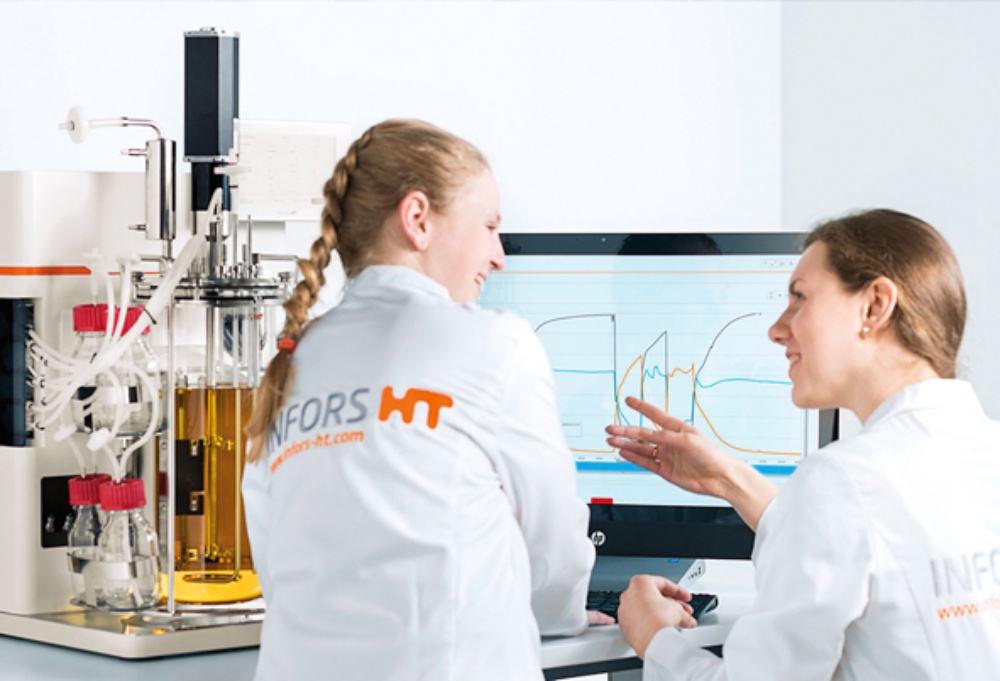Efficient, digital bioprocess control
Big Data has opened up a new chapter in biological research. Infors AG worked with Noser Engineering to develop a new software suite designed to give researchers more in-depth insight into their experiments while simultaneously recording a full audit trail.
 Infors AG aims to revolutionize the bioreactor and incubation shaker market with a new bioprocess control software system. The force behind the development is once again big data.
Infors AG aims to revolutionize the bioreactor and incubation shaker market with a new bioprocess control software system. The force behind the development is once again big data.
Incubation shakers and bioreactors are key pieces of equipment in the biotechnology and pharmaceuticals industries, as both provide ideal growth conditions for microorganisms and for mammalian and plant cells. Suitable bioprocess control software with ingenious algorithms based on analytical data and process models can continuously optimize those conditions, allowing researchers to precisely control the growth of organisms—and thus product yield and quality. This means having to collect and understand an increasingly large volume of process data, so that the resulting information and knowledge can be used in many stages of the process. Big data is finding its way into biotechnology, revolutionizing the options that companies have for efforts such as reducing time to market, a critical parameter in the pharmaceuticals industry. Infors AG recognized the potential early on and three years ago began replacing all of its established bioprocess control and analysis software with a modern, web-based solution— gearing the company towards the future.
To implement that vision, Infors AG brought experts from Noser Engineering AG on board to support its in-house development team. Working directly on site, the interdisciplinary team used agile methods to develop the eve® bioprocess platform software, which is composed of numerous complex, interacting modules.
Preparing individual reports
eve® is a server-based system that works from within the company network, sending commands to devices and collecting process data via a standard such as OPC (DA, XML- DA and UA). All of the data are stored in a central location and can be called up via HTTP or REST API. An important part of the solution is the reporting component developed by Noser Engineering. Embedded in the entire system, this component consists of a wizard and a reporting engine, with the former allowing users to compile reports that meet individual criteria, and the latter visualizing the results. The reporting engine is seamlessly integrated into the web interface and can preview reports in HTML5 and export them to predefined formats such as PDF, Word, PowerPoint and Excel.
In keeping with the theme of big data, the reporting engine is also connected to a database in which new measurement data are recorded every second from all sensors across a number of devices. “While the frequency and volume of data may seem small, this represents a minor revolution in the field of biotechnology. A lot of laboratories still use multiple independent systems with data files in unstructured storage,” says Eric Abellan, a product manager at Infors AG. The trick is to store the increasing volume of data in such a way that CPU- intensive analyses and data retrieval can be as efficient as possible and the user can draw meaningful conclusions about the content. “Classic SQL databases are too limited for this new world,” says Eric Abellan.
Making sense of mountains of data
For this reason, Noser Engineering worked with the Infors AG team to implement the ElasticSearch database, which is designed for large volumes of data. The technology is used throughout the world by such giants as Netflix and CERN, and its modern features are what allow users to convert huge masses of data into a report that is understandable on a human scale. “An experiment lasting several weeks can quickly generate millions of data points,” says Dennis Alberti of Noser Engineering. “ No reporting engine can represent that easily.
There just aren’t enough pixels to plot a chart with that many data points.” ElasticSearch makes it possible to distill those data down to 300 – 400 data points.
To optimize speed, the reporting engine does not search the database directly but instead receives finished data packets via ElasticSearch. In this way, Noser has decoupled the reporting component from the deeper elements of eve® software. Because this modular concept runs through the entire software package, individual components can be replaced anytime.
eve® also meets FDA and EMA regulatory requirements and can be validated accordingly —this requires features such as the ability to track all interactions between the user and the platform. The database preserves an uninterrupted record of who did what, when and in which experiment. “That allows us to provide full audit trails quickly,” Eric Abellan notes.
The new eve® software has been on the market since October of 2016. “In our work with Noser Engineering, we managed to create a completely new kind of solution. Right now we’re the only ones offering that kind of functionality,” Eric Abellan points out. According to Infors AG, initial customer feedback has been positive, and interest on the market has been high. That may also be due to the fact that eve® has another little surprise to offer: in addition to the company’s own hardware, the solution also works with third-party devices.